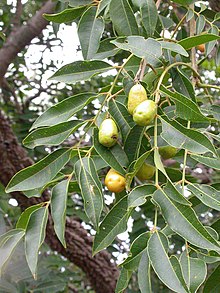Spondias mombin
| Spondias mombin | |
|---|---|
 |
|
| S. mombin, fruiting. | |
| Scientific classification | |
| Kingdom: | Plantae |
| (unranked): | Angiosperms |
| (unranked): | Eudicots |
| (unranked): | Rosids |
| Order: | Sapindales |
| Family: | Anacardiaceae |
| Genus: | Spondias |
| Species: | S. mombin |
| Binomial name | |
|
Spondias mombin L. |
|
| Synonyms | |
|
|
Spondias mombin or Spondias purpurea var. lutea, is a tree, a species of flowering plant in the family Anacardiaceae. It is native to the tropical Americas, including the West Indies. The tree has been naturalized in parts of Africa, India, Bangladesh, Sri Lanka and Indonesia. It is rarely cultivated except in parts of the brazilian Northeast.
The mature fruit has a leathery skin and a thin layer of pulp. The seed has an oil content of 31.5%.
The fruit pulp is either eaten fresh or made into juice, concentrate, jellies, and sherbets.
In Thailand this fruit is called makok (Thai: มะกอก) and is used in som tam as a secondary ingredient. The young leaves, which taste slightly bitter and sour, are sometimes served raw together with certain types of nam phrik (Thai chilli pastes). It is also served with chilli powder in Bangladesh where the fruit is known as amṛa.
As a member of the Sumac family (Anacardiaceae), exposure to the sap of this species may result in an identical allergic reaction to that of the poison ivy plant. Those with a known sensitivity to urushiol should exercise caution in consuming or handling this species.
The fruit-juice is used as a febrifuge and diuretic. The roots are well-known febrifuge on the Ivory Coast, being sometimes used with leaves of Ximenia, Premna hispida, Ficus sp., and Alchornea. They are pulped, boiled in water, and drunk, or used as a lotion or for baths. The bark is used as a purgative and in local applications for leprosy (Kerharo and Bouquet). The bark decoction is used for severe cough, causing relief through vomiting. The dry pulverized bark is applied as a dressing to the circumcision wound. The bark contains a certain amount of tannin. A decoction of the mashed leaves is used by the Ibos (Nigeria) for washing a swollen face. The leaves, ground with sugar, are rubbed on the mouth and gums. A leaf infusion is a common cough remedy or used as a laxative for fever with constipation. A leaf decoction is used for gonorrhea. The leaves with the leaves of Vitex quinata and Terminalia avicennoides, are used on the Ivory Coast for fresh wounds preventing inflammation. All these leaves are used for leprosy. Crushed with lemon they are effective for worms in children. With Alchornea leaves and lemon a gargle is made from the leaves. They are crushed to obtain the juice. A decoction of pounded leaves is used as an eye lotion and the juice pressed from young, warm leaves is given to children for stomach troubles. The young leaves are used as an infusion taken internally or as a warm astringent lotion by women in confinement in Sierra Leone. In the Congo the young leaves pounded to a frothy pulp are used as a bed for paralytics, who are then massaged with them to the accompaninent of incantations. In Suriname's traditional medicine, the infusion of the leaves is used as a treatment of eye inflammation, diarrhea and venereal diseases.
...
Wikipedia
